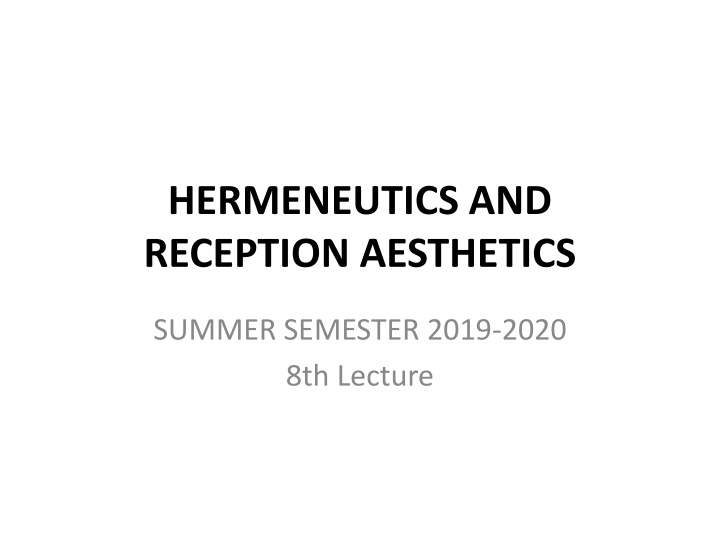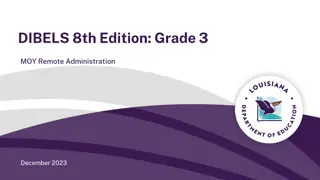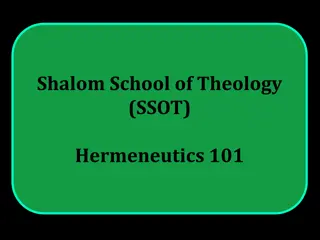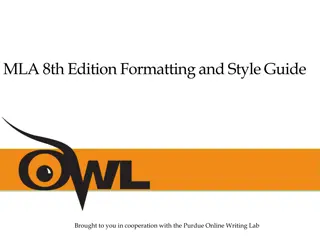
Key Concepts in Hermeneutics and Reception Aesthetics Lecture
Explore the fundamental concepts of hermeneutic experience, including prejudices, temporal distance, and the principle of history of effect. Delve into the interplay between familiarity and strangeness in interpreting texts, and understand the task of hermeneutics in clarifying conditions for understanding without rigid methodologies. Discover how productive prejudices aid understanding and the role of temporal distance in separating hindering prejudices.
Download Presentation

Please find below an Image/Link to download the presentation.
The content on the website is provided AS IS for your information and personal use only. It may not be sold, licensed, or shared on other websites without obtaining consent from the author. If you encounter any issues during the download, it is possible that the publisher has removed the file from their server.
You are allowed to download the files provided on this website for personal or commercial use, subject to the condition that they are used lawfully. All files are the property of their respective owners.
The content on the website is provided AS IS for your information and personal use only. It may not be sold, licensed, or shared on other websites without obtaining consent from the author.
E N D
Presentation Transcript
HERMENEUTICS AND RECEPTION AESTHETICS SUMMER SEMESTER 2019-2020 8th Lecture
Elements of a theory of hermeneutic experience See: H.-G. Gadamer, Truth & Method, p. 267- 306. Three main concepts constituting the conditions of possibility of hermeneutic experience, three factors accompanying every experience which has a hermeneutic character: I. Prejudices; II. Temporal Distance; III. The Principle of history of effect
Recapitulation of the previous 7thlecture Prejudices Neutrality, Objectivity. Different usage of the meaning of prejudice in historical development The concept of authority and tradition The role of tradition in human and natural sciences. See presentation from previous lecture.
II. The concept of temporal distance
In every hermeneutic experience, there is a polarity between (1) familiarity and (2) strangeness. It is this polarity on which the hermeneutic work is based: (1) The subject matter that comes into language is always understood from the perspective of the tradition the interpreter belongs to (the person seeking to understand something has a bond to the subject matter). (2) The subject matter is a historically intended, distanced object and the person must acquire a connection with the tradition from which the text speaks (e.g. battle of Thermopylae; the day of burning of master Jan Hus; Old Town Square Execution). = Hermeneutics is this in-between. It is situated between familiarity and strangeness.
The task of hermeneutics is not to develop a procedure of understanding, but to clarify the conditions in which understanding takes place These conditions do not amount to a method and cannot be transformed into method, rather they must be given. An unmethodical approach of the layman is closer to Gadamerian hermeneutics than methodology of reputed scientists and intellectuals.
One cannot distinguish in advance the productive prejudices that enable understanding from the prejudices that hinder it and lead to misunderstandings . This separation must take place in the process of understanding itself, and hence hermeneutics must ask how that happens == this is why Gadamer has introduced the concept of temporal distance in which this separation can appear.
It is not possible to familiarize with the past of the text in the sense that we would be able to reproduce an original production, i.e., an authorial original intention by means of which the author wanted to address his recipients. One must count on an insuperable difference between the interpreter and the author that is created by historical distance. To recognize temporal distance as a positive and productive condition enabling understanding.
The temporal distance is not a yawning abyss but is filled with the continuity of custom and tradition, in the light of which everything handed down presents itself to us . The temporal distance makes possible that all prejudices of a particular nature have faded away and the real nature can appear, so that the understanding of what is said in them can claim to be authoritative and universal. When looking back at the history, we are more often able to recognize the ways of interpretations that have indeed proved to be effective.
On the curious impotence of our judgment Everyone is familiar with the curious impotence of our judgment where temporal distance has not given us sure criteria. Thus the judgment of contemporary works of art is desperately uncertain for the scholarly consciousness. Obviously we approach such creations with unverifiable prejudices, presuppositions that have too great an influence over us for us to know about them; these can give contemporary creations an extra resonance that does not correspond to their true content and significance. Only when all their relations to the present time have faded away can their real nature appear, so that the understanding of what is said in them can claim to be authoritative and universal (T&M, p. 297).
A hint of critique of Gadamer In the above quotation we see how careful Gadamer is. It seems that hermeneutics must wait for the temporal distance so that it can evaluate a given work of art properly. It is not premature, indeed, yet insufficiently non- engaged. Compare this approach with J.-P. Sartre, M. Foucault and others who preferred being false to standing aside and waiting.
Gadamerian critique of the method of historicism Historicism the permanent significance of something can first be known objectively (as an objective knowledge) only when it belongs to a closed context, i.e. when it is dead enough. Gadamer the temporal distance obviously means something other than the extinction of our interest in the object it lets the true meaning of the object emerge fully. It distinguishes the true prejudices, by which we understand, from the false ones, by which we misunderstand. The encounter with the historical event which differs from our own situation leads us to a confrontation. This encounter (with the traditionary text) provokes our prejudices (suspending the validity of prejudices).
Unity of the subject matter and the interpreter It is not possible to disregard of ourselves (this was the naivety of historicism) the true historical object is not an object at all, but the unity of the one and the other. The interpreter must think over his proper historicity (historicism forgets its own historicity) and learn to know in the hermeneutic object the other from within his own situatedness.
Read: H.-G. Gadamer, The hermeneutic significance of temporal distance, in Truth and Method, p. 291-299.
III. The principle of the history of effect (Wirkungsgeschichte)
The awareness of the history of effect is not new, it is not a matter of Gadamerian hermeneutics. The interest was long before Gadamer focused on the effect of works of the past (= works of art, theoretical works, or all what Gadamer calls traditionary works ) in the course of history. Gadamer has showed this in T&M when exposing different understanding of meanings of some concepts in the process of history (Cf. concepts of the humanist tradition; the concept of the prejudice; and so on). the way of how a certain work of art or theory has had effected in the course of history; E.g.: the reception of M cha s May [M j] from its release until today.
This shows that texts (traditionary works) evoke different interpretations in different periods of time and they actually must evoke them. According to Gadamer, this effect of history needs to be integrated into hermeneutics. An inquiry into history of effect is in accordance with the condition of consciousness of the hermeneutical situation and with the productivity of the temporal distance. It is required every time a work of art or an aspect of the tradition is led out of the twilight region between tradition and history so that it can be seen clearly and openly in terms of it own meaning (p. 299).
How to describe the principle of history of effect? How make it a hermeneutic principle? Historicism, historical objectivism relies on its method; conceals the fact that historical consciousness is itself situated in the web of historical effects; postulates a historical distance. Historical objectivism resembles statistics, which are such excellent means of propaganda because they let the facts speak and hence stimulate an objectivity that in reality depends on the legitimacy of the questions asked , p. 300.
Hermeneutics the efficacy of history is at work in all our understanding, no matter if we are expressly aware of it or not. Hermeneutics should reveal the fact of historicity in understanding itself. Consciousness of being affected by history (wirkungsgeschichtliches Bewusstsein) is primarily consciousness of the hermeneutic situation. (= situation in which we find ourselves with regard to the tradition that we are trying to understand).
Verschmelzung der Horizonten [Fusion of Horizons] When our historical consciousness transposes itself into historical horizons, this does not entail passing into alien worlds unconnected in any way with our own; instead, they together constitute the one great horizon that moves from within and that, beyond the frontiers of the present, embraces the historical depths of our self-consciousness. Everything contained in historical consciousness is in fact embraced by a single historical horizon. Our own past and that other past toward which our historical consciousness is directed help to shape this moving horizon out of which human life always lives and which determines it as heritage and tradition , T&M, p. 303.
Read: H.-G. Gadamer, The Principle of History of Effect (Wirkungsgeschichte), in Truth and Method, p. 299-306.






















